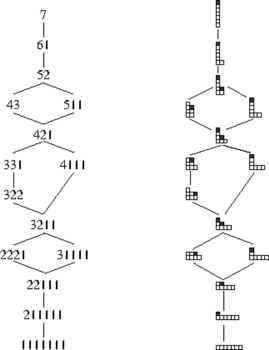Lattices are prevalent when one deals with integer partitions.
Let me give a few examples with pictures, that I hope you will enjoy despite the poor quality due to bitmap conversion.
The dominance order, that you already cited, is a lattice; it is not distributive and not graded, but it has nice self-similar properties. Here is a picture of its Hasse diagrams for $n=7$ and $n=20$:


The reachable configurations of the linear Sand Pile Model (SPM), where one starts with a pile of $n$ grains, and they may fall under the condition that the sequence of piles remains decreasing, is also a lattice. It is a sub-order of the lattice above. It is not distributive either, but it is graded, and has nice self-similar features too. Here is the Hasse diagram for $n=40$.

Ice Pile Models (IPM) are generalizations of the two above cases, where the grains may slip from one column to another under some conditions. The induced orders are non-graded lattices, and one may obtain not only partitions but also compositions of a given integer.
The examples above are partitions of a given integer; one may also consider integer partitions of given maximal part and/or number of parts.
This leads to finite distributive sub-lattices of the Young Lattice, strongly related to Dyck paths, already cited in previous answers. For instance, if we consider partitions in at most $3$ parts of value at most $3$, we obtain the following representations (the rightmost one is the lattice of Dyck paths with three steps in each direction):



These can be generalized to plane partitions (or piles of cubes), solid partitions and actually generalized integer partitions on graphs introduced, I think, by Stanley in his seminal book "Ordered Structures and Partitions". Again, we obtain distributive lattices, and here is the case of planar partitions contained in a 3x3x2 volume:

As you may see above, these partitions are equivalent to tilings of an hexagon with lozenges, with the order induced by flips of three tiles. In higher dimensions, we obtain tilings of 2D-gons, with the same flip ordering. They are not always lattices, but they are disjoint unions of distributive lattices, because of their relation to generalized integer partitions. For instance, here is the set of all tilings of a unit decagon:

Other kinds of tilings with flips induce distributive lattices, like tilings by dominoes, and generalized tilings with height functions.
Let me add a last example, because I love its drawing. If one considers, for a given $b$, the different ways to write a given number $n$ as a sum of powers of $b$, then one obtains a self-similar distributive lattice. For instance, for $n=80$ and $b=2$:










